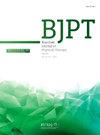脑卒中后白质完整性与下肢运动障碍之间的关系:一项系统综述:脑卒中后白质完整性与下肢运动障碍。
IF 3.1
3区 医学
Q1 ORTHOPEDICS
引用次数: 0
摘要
背景:对于脑卒中后下肢损伤恢复所需的解剖学基础,目前还没有明确的共识。生物标志物的知识,如白质完整性(WMI),可以填补这一知识空白。目的:分析脑卒中后皮质脊髓束(CST)和皮质网状脊髓通路(CRP) WMI与LL运动障碍的协同控制和肌力的关系。它还探讨了是否有任何关联取决于中风后的时间。方法:于2023年4月系统检索PubMed、Web of Science和Scopus数据库,检索脑卒中后CST和CRP WMI与LL运动障碍相关的研究。使用纽卡斯尔-渥太华质量评估量表评估偏倚风险。结果:共纳入19项研究,其中15项研究涉及CST与运动障碍的关系,4项研究涉及CST与CRP的关系。CST的高WMI与更大的肌肉力量之间一致存在关联,但与协同控制无关。CRP的WMI与肌肉力量之间没有明确的关联,并且无法分析这种关联以进行协同控制。结果不能确定这种关联是否与时间有关。结论:本综述的结果支持使用CST的WMI来了解脑卒中后LL肌肉力量。然而,由于研究较少,对于LL协同控制则不能这样说。由于结果不一或缺乏研究,没有明确的证据表明CRP的WMI与LL肌肉力量或协同控制之间存在关联。本文章由计算机程序翻译,如有差异,请以英文原文为准。
Association between white matter integrity and lower limb motor impairment after stroke: A systematic review
Background
There is no clear consensus on the anatomical substrates required for recovery from lower limb (LL) impairment after stroke. Knowledge of biomarkers, such as white matter integrity (WMI), could fill this knowledge gap.
Objectives
To analyze the associations between WMI of the corticospinal tract (CST) and corticoreticulospinal pathway (CRP) and LL motor impairment after stroke, in terms of synergistic control and muscle strength. It also explores whether any associations depend on time post-stroke.
Methods
In April 2023, PubMed, Web of Science, and Scopus databases were systematically searched for studies associating WMI of the CST and CRP and LL motor impairment after stroke. Risk of bias was assessed using the Newcastle–Ottawa Quality Assessment Scales.
Results
Nineteen studies were included, 15 about the association between CST and motor impairment, and 4 concerning CST and CRP. Associations were consistently found between higher WMI of the CST and greater muscle strength, but not with synergistic control. There were no clear associations between WMI of the CRP and muscle strength, and associations could not be analyzed for synergistic control. The results could not determine whether the associations are time dependent.
Conclusions
The results of this review supported using WMI of the CST to understand LL muscle strength after stroke. However, the same cannot be said for LL synergistic control due to the small number of studies. There was no clear evidence of an association between WMI of the CRP and LL muscle strength or synergistic control due to mixed results or a lack of studies.
求助全文
通过发布文献求助,成功后即可免费获取论文全文。
去求助
来源期刊
CiteScore
6.10
自引率
8.80%
发文量
53
审稿时长
74 days
期刊介绍:
The Brazilian Journal of Physical Therapy (BJPT) is the official publication of the Brazilian Society of Physical Therapy Research and Graduate Studies (ABRAPG-Ft). It publishes original research articles on topics related to the areas of physical therapy and rehabilitation sciences, including clinical, basic or applied studies on the assessment, prevention, and treatment of movement disorders.

 求助内容:
求助内容: 应助结果提醒方式:
应助结果提醒方式:


